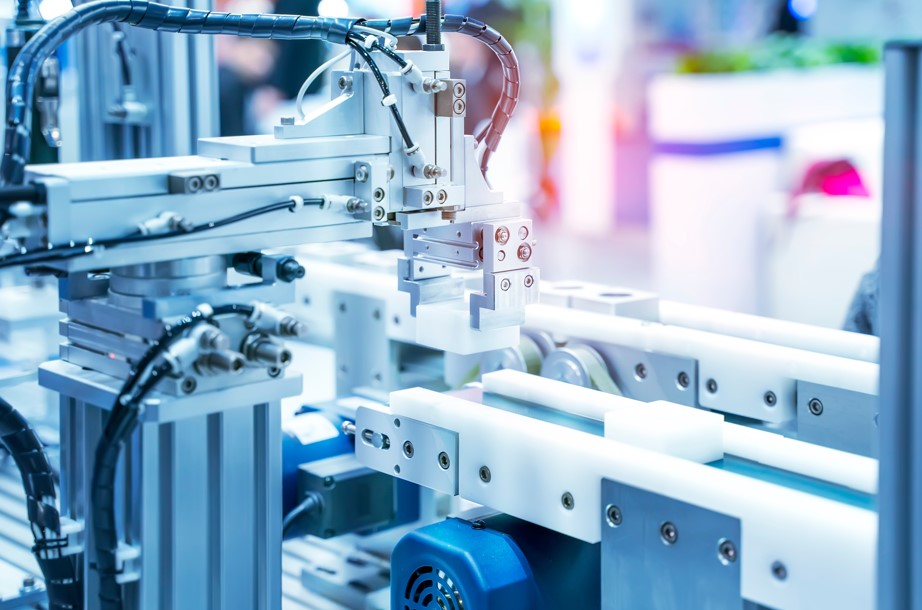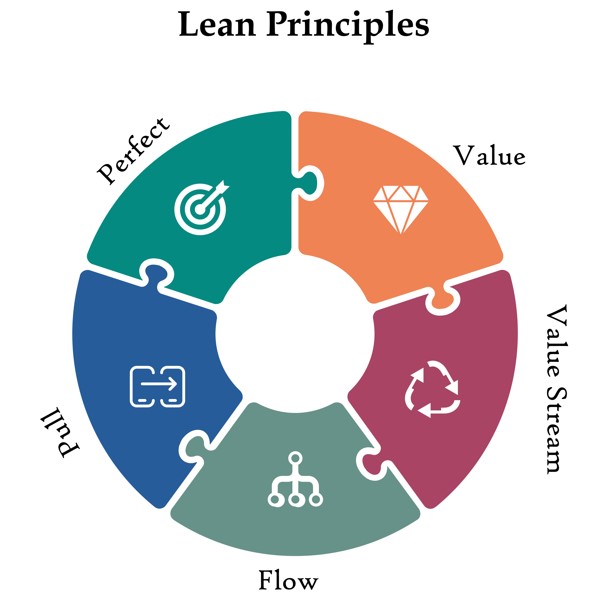
The manufacturing industry consists of multiple moving parts – both literally and figuratively. But with so many variable factors that go into the production process, it can be hard to optimize your systems and workflows to ‘trim the fat’ and eliminate waste.
This is where lean manufacturing comes in. This systematic approach creates a customer-focused production line that streamlines your processes so that you benefit from more productivity, continuous improvement, and less waste. In turn, this also means fewer costs.
To fully understand this technique, however, you first need to understand the five lean manufacturing principles and how they work together.
What Is Lean Manufacturing?
Lean manufacturing is a management philosophy that focuses on maximizing efficiency in the production process while minimizing waste. The concept of lean manufacturing originates from the Toyota Production System (TPS), which aimed to create more value for customers while using fewer resources.
Essentially, the fundamental goal is to boost your profitability and productivity. This is done through streamlining your operations and reducing inefficiencies.
The primary focus of lean manufacturing includes:
- Optimizing workflows: This involves streamlining your tasks to minimize delays and potential redundancies.
- Improving quality: You’ll need to implement quality control measures to reduce the risk of defects and improve product reliability.
- Boosting productivity: Boosting productivity requires you to identify and remove any activities that don’t add value to your manufacturing processes. This can help to maximize your output and utilize your resources more efficiently.
At the heart of lean manufacturing are two core ideas:
1. Continuous improvement
This idea emphasizes improving products, services, or production processes within your manufacturing system. So, when you implement lean manufacturing, you will need to adopt a mindset of regular evaluation and adjustment or refinement. Additionally, you’ll need to encourage all your employees to contribute towards ideas for improvement.
When you use this approach, you ensure that your business can adapt to changes in customer demand and shifts within the market. Continuous improvement fosters a culture not only of innovation but also of responsiveness to these changes.
2. Elimination of non-value-adding activities
Lean manufacturing aims to help you identify and remove any activities that don’t directly contribute to your business’s value (as it is perceived by your customers). Ultimately, the key to this idea is reducing waste.
By focusing on value-adding processes, you can streamline your operations, reduce costs, and deliver higher-quality products. But part of this process is critically assessing every step in your production line to determine its necessity and efficiency. As a result, you can eliminate waste in various forms, such as excess inventory, defects, and waiting times.
The 5 Essential Lean Manufacturing Principles
The lean manufacturing process relies on five main principles to work effectively. These include value, the value stream, continuous flow, a pull system, and Kaizen.
To fully understand how these principles of lean manufacturing work together and what they mean as part of the ‘bigger picture’, it’s critical to understand what each of them entails.

1. Identify value
Value is defined by your customer. But what is value when it comes to lean manufacturing?
It refers to the features and benefits that meet customer needs and are worth the price they’re willing to pay. This means that it’s essential to understand what your customers value in your products or services.
To fully understand this, you need to engage with your customers to gather feedback and insights. That way, you can ensure that the products you develop are aligned with their requirements and expectations.
2. Map the value stream
The second key principle is mapping the value stream. The value stream consists of all the actions (both value-adding and non-value-adding) that are involved in producing a product from start to finish.
By mapping out the entire process, your organization can visualize each step involved in production. They can also identify waste and understand how value flows to the customer, pinpointing areas for improvement and can streamline your processes.
3. Create flow
Flow refers to the smooth, uninterrupted movements of products as they go through the production process. With lean manufacturing, the objective is to remove any obstacles that disrupt this flow of materials or information.
Part of creating flow includes:
- Rearranging equipment
- Optimizing workstations and workflows
- Making sure that all the steps in the production process are connected
Together, this allows for a quicker transition between tasks and a smoother production flow.
4. Establish a pull system
Rather than relying on forecasts and producing products in advance (a push system), a pull system only produces items if and when they’re needed, based on customer demand.
When you implement a pull system, you can minimize the risk of overproduction and excess inventory. This, of course, is essential in eliminating waste. Techniques like Just-In-Time (JIT) production or kanban are ideal for creating this demand-driven approach. They also ensure that your products are only made when your customers require them.
5. Kaizen
Continuous improvement, also known as Kaizen, places emphasis on the need for ongoing and incremental improvements in every area of your organization. When you use this method, you’ll need to encourage everyone in your business to identify problems, come up with solutions to these problems, and suggest improvements in their areas of expertise.
When these improvements are implemented, they will need to be monitored and their impact measured. That way, you can determine whether the changes were successful. If they aren’t as successful as you forecast them to be, then you can adjust them as necessary.
The Benefits Of Lean Manufacturing

Implementing a lean production system has significant advantages for your organization. This is particularly true in the areas of productivity, cost efficiency, and product quality.
Increased productivity
One of the main goals of lean manufacturing is eliminating waste and improving your business process management. For instance, waste in the form of overproduction, waiting times, unnecessary motion, and defects can all slow your manufacturing workflow.
How it leads to better productivity
By streamlining your processes and only focusing on activities that add value, your workers will spend less time on tasks that don’t contribute to the final product. Additionally, when you remove bottlenecks and reduce downtime, you’ll benefit from a faster and smoother production process.
When you implement lean manufacturing tools like Just-In-Time, you can ensure that production occurs exactly when you need it. This boosts your efficiency and frees up time and resources for more valuable tasks.
Ultimately, lean thinking creates an environment where your employees can work more efficiently, leading to a higher output without increasing your resource usage.
Cost efficiency
A lean manufacturing system is designed to minimize waste and the use of precious resources, which directly impact the operational costs of your business. So, the sooner you can deploy new systems within the manufacturing process, the faster you can cut down on costs.
The financial benefits of lean practices
- Reduced inventory cost: Lean manufacturing techniques focus on pull systems and JIT manufacturing. This helps your company avoid overproduction and reduces the risk of excess inventory. Subsequently, this creates a domino effect where less inventory means lower storage costs and fewer handling expenses.
- Lower defect rates: Continuous improvement and better quality control lower the risk of defective products. In turn, this reduces the costs associated with reworks, scrapping, returns, and wasted raw materials.
- Energy and material savings: When you eliminate steps that aren’t adding value to the production process, you can effectively reduce your energy consumption and the waste of raw materials. This directly lowers your production costs.
- Better resource allocation: Using your resources unnecessarily can add up to costly processes that don’t benefit your production line. Lean practices ensure that your employees and machinery are only used when they’re needed. As a result, you can optimize your resource use and save significantly on your manufacturing processes.
Better product quality
Continuous improvement is a core principle of lean manufacturing which can directly impact the quality of your products. It encourages your organization to constantly seek out ways to improve manufacturing processes.
How continuous improvement leads to better product quality
A lean manufacturing system emphasizes the need to identify and eliminate defects and process variability. As a result, your company will experience fewer errors and produce more consistent, high-quality products.
By focusing on what your customer wants, you can continually refine your production process to meet their needs. That way, your products will also be designed and produced to much higher standards.
Of course, the easiest way to implement continuous improvement is through workflow automation designed for manufacturing.
Implementing A Lean Manufacturing System
Implementing a lean manufacturing system into your existing production processes is easier than you may think. It all boils down to a few simple steps:
- Set SMART goals: Establishing certain goals helps to guide the lean manufacturing system, and ensures that your objectives are precise and trackable. Ideally, you should implement SMART goals: Specific, Measurable, Achievable, Relevant, and Time-bound.
- Audit the entire supply chain: You should also conduct an audit of your supply chain, from sourcing your raw materials to the final delivery of your products. This can help you pinpoint delays or excess inventory.
- Prioritize inventory management: Be sure to implement systems like JIT to produce and hold inventory only if and when it’s needed.
- Create a preventative maintenance schedule: Equipment breakdowns can cause unplanned and costly downtime. By creating a maintenance schedule to inspect, service, and replace parts or equipment as needed, you can eliminate the risk of downtime altogether.
- Re-evaluate your packing processes: Packing and shipping inefficiencies can lead to wasted materials, meaning you should minimize unnecessary handling and make transport more efficient.
The Role Of Technology In Lean Manufacturing
Technology plays a major role in improving your lean manufacturing processes. In fact, it’s essential for streamlining your operations to reduce waste more efficiently than ever. This digital transformation is also happening faster than ever, making it essential to implement technology to stay ahead of the competition.
So, by integrating advanced lean manufacturing tools like HighGear’s solutions, you can easily optimize your production workflows, increase your efficiency, and maintain your competitive edge.
One of the most significant ways that HighGear helps lean manufacturing is by automating manual processes. Although your old legacy systems may have worked in the past, it may be time to amp them up using our platform.
HighGear can help you create, manage, automate, and tweak your workflows without the need for complex programming. Plus, our no-code software has been specifically designed to simplify and streamline certain tasks, including:
- Continuous improvement
- Data-driven decision making
- Team collaboration
- Adopting workflows on the fly
FAQs
What are the seven types of waste in lean manufacturing?
Since lean manufacturing is all about eliminating waste, it’s important to know where waste is found. The seven types of waste are:
- Overproduction
- Transport
- Waiting
- Over-processing
- Defects
- Inventory
- Motion
What is the difference between Lean and Six Sigma?
While lean manufacturing focuses on minimizing waste, Six Sigma’s focus is on reducing the variation within your production process. There are five phases of Six Sigma, known as DMAIC. This stands for:
- Define
- Measure
- Analyze
- Improve
- Control
Final Thoughts
Implementing lean manufacturing principles into your manufacturing process has never been easier. With the use of comprehensive workflow automation software like HighGear, you can ensure that all of your essential processes are made more streamlined and efficient than ever.
Are you ready to experience the benefits of HighGear for yourself? Then be sure to book your free demo with us today. Our platform will help you to revolutionize your manufacturing process in no time at all.
